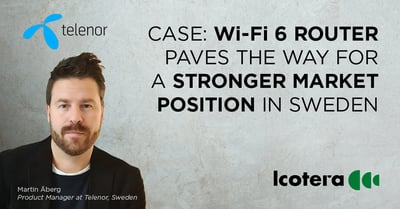Consumers are becoming more environmentally conscious and being able to meet their demands with less carbon-intensive Wi-Fi solutions is becoming a competitive parameter for ISPs. The good news is, that with a high-end single router solution, you can reduce the negative impact on the environment and benefit your business. In this article, we explain how.
Global warming struck again this summer and sharpened everyone’s focus on the climate change impacting us all. Investment in the green transition has accelerated significantly in recent years, and climate-conscious consumers are gaining ground fast:
- Consumers are becoming more focused on the sustainability agenda and how they can drive positive change through their consumption. I’m certain that we’ve only seen the beginning of this trend, and that demand for organizations to deliver more sustainable products and services will only increase, including for Wi-Fi services, Erik Søe-Pedersen, Chief Commercial Officer at Icotera, says and continues:
- The internet industry is by its nature carbon-intensive. But this only makes our responsibility more pressing. As an ISP, you should therefore consider how you can make a difference through your business strategy and by offering customers a step up on the sustainability agenda.

“Consumers are becoming more focused on the sustainability agenda and how they can drive positive change through their consumption. I’m certain that we’ve only seen the beginning of this trend, and that demand for organizations to deliver more sustainable products and services will only increase, including for Wi-Fi services.” Erik Søe-Pedersen, Chief Commercial Officer, Icotera
Limit your carbon footprint with fewer devices
Sustainable choices are often associated with increased costs. But according to the Chief Commercial Officer, it is possible for ISPs to make strategic investments and reduce their carbon footprint while also improving their business in the long run.
The recipe is simple: Install fewer devices in your end-users’ homes.
- In recent years, a perception has evolved that the more devices you install, the better the internet performance you’ll get. But this is not always true. Of course, there are instances where a mesh solution is ideal, for example if you have a four-floor house to cover. But instead of plastering homes with mesh units and extenders by default, the more responsible approach is to choose intelligent solutions, Erik Søe-Pedersen says.
His key argument is: It’s much better to strive to deliver a simple solution with a single high-end router covering the entire home.
Lower your TCO with an intelligent solution
According to Erik Søe-Pedersen, one single Wi-Fi 6 high-end router can easily replace several average mesh units. Furthermore, consumers will have a better user-scenario if they only have to consider placement of one device:
- The more devices you connect to your network, regardless of whether they’re mesh units or extenders, the more sources of errors. With fewer potential sources of errors, you can troubleshoot customer issues much more efficiently, thereby lowering costs for both support calls and expensive truck rolls. Mesh units or extenders also reduce the free airtime and thereby they potentially reduce Wi-Fi performance in the home.
There is also an obvious impact on the environment when you choose a single router solution:
- You lower your carbon footprint when you reduce the number of devices. The more electronic devices we put in our homes, the more devices have to be produced and transported, and the more devices will ultimately have to be trashed. Simply put, a high-end router means you can offer a less carbon-intensive solution. As an ISP, you should never underestimate the commercial value of this, Erik Søe-Pedersen says. He adds:
- Naturally, one router consumes less energy than four mesh units, for example. With the galloping energy prices right now, this too is an important consideration.
Meeting the needs of tomorrow
With accelerating digitalization, end-users’ demand for stable and high-speed internet access will only go one way. If you install average routers in end-users’ homes, you can rest assured that your service will fall behind when your customers need more speed and stability.
- ISPs should always strive for the most future-proof solution. You can save a lot of money if you right-size from the beginning, by installing equipment that can meet the demands for years to come, so you don’t have to replace the customer premise equipment as often. There’s a huge difference in whether you have to replace the router once or twice during a ten-year period. For the environment, and for your business, Erik Søe-Pedersen ends.
-----------------------------------------------------------------------------------
![]()
WANT TO KNOW MORE about how other ISPs have improved their business with a high-end Wi-Fi 6 router? Read the Telenor case here.


